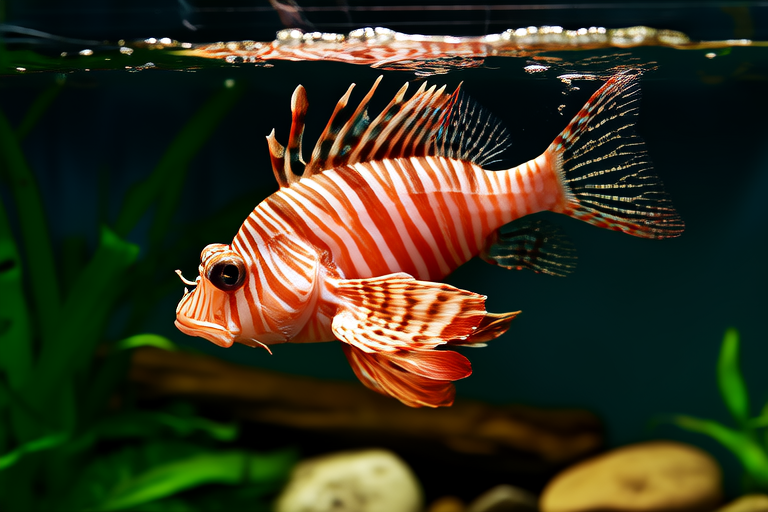Goldfish Behavior Decoded: Understanding Your Pet’s Actions
Welcome to the fascinating world of goldfish! These delightful creatures are more than just colorful ornaments in your aquarium; they are intelligent pets that exhibit a range of behaviors that can be both intriguing and rewarding to observe. This article aims to decode the behavior of goldfish, helping you understand their actions, improve their welfare, and strengthen the bond between you and your aquatic friends.
Basic Goldfish Behavior and Communication Methods
Goldfish are social animals that communicate through various behaviors. They use their body movements, tail flicks, and even changes in color to express themselves. For instance, when a goldfish is excited or stressed, it might flash its colors more vibrantly. In terms of body language, a relaxed fish will swim gracefully, while a stressed one may dart around the tank erratically. Understanding these basic behaviors is crucial for recognizing their needs and ensuring their well-being.
Common Behaviors: Swimming Patterns and Eating Habits
One of the most noticeable aspects of goldfish behavior is their swimming patterns. Goldfish are generally active swimmers and can often be seen exploring their environment. However, changes in swimming patterns can indicate underlying issues. For example, if a goldfish is swimming upside down or struggling to maintain balance, this could be a sign of illness.
Eating habits also vary among goldfish. Healthy goldfish will eagerly accept food, whereas those that are ill or stressed may refuse to eat. It’s important to offer a balanced diet consisting of pellets, flakes, and occasional treats like brine shrimp or daphnia. Overfeeding can lead to poor water quality and health issues, so it’s essential to monitor their feeding carefully.
Responses to Stimuli
Goldfish are highly responsive to their environment. They react to changes in lighting, temperature, and even the presence of other fish. A sudden change in lighting can cause them to hide or become more active, depending on the individual fish. Similarly, the introduction of new fish can lead to aggression or playful interactions. Understanding these responses helps in creating a stable and enriching environment for your goldfish.
Identifying Signs of Health and Stress in Goldfish
Recognizing signs of health and stress in goldfish is vital for their longevity. Common indicators of a healthy goldfish include clear eyes, vibrant coloration, and regular swimming. Conversely, signs of stress or illness include lethargy, pale coloration, erratic swimming, and loss of appetite. Regularly checking your goldfish for these symptoms can help catch problems early and prevent them from worsening.
To ensure your goldfish remain healthy, it’s crucial to maintain optimal water conditions. Regular water changes and monitoring of pH, ammonia, and nitrite levels are essential. Additionally, providing a varied diet and avoiding overfeeding can significantly reduce stress and promote good health.
Environmental Factors Affecting Behavior
The environment plays a significant role in shaping goldfish behavior. Tank size is a critical factor; goldfish require ample space to swim freely. A small tank can lead to cramped conditions, causing stress and behavioral issues. Ideally, each goldfish should have at least 20 gallons of water, though larger tanks are always better.
Water quality is another key aspect. Poor water quality can lead to respiratory problems, skin disorders, and other health issues. Regular filtration and maintenance are necessary to keep the water clean and safe for your goldfish. Additionally, providing companionship through tank mates can enhance their social interactions and overall well-being. However, it’s essential to choose compatible species to avoid aggressive behavior.
Tips for Enhancing Goldfish Interaction and Engagement
To enhance the interaction and engagement of your goldfish, consider incorporating enrichment activities into their daily routine. These activities can include hiding places, plants, and toys that stimulate their curiosity and provide mental stimulation. Interactive feeding, where you scatter food across the tank, encourages natural foraging behavior and keeps them engaged.
Proper care is fundamental to maintaining a happy and healthy goldfish. This includes regular cleaning of the tank, monitoring water parameters, and providing a nutritious diet. By paying attention to these aspects, you can ensure your goldfish live long, fulfilling lives.
In conclusion, understanding goldfish behavior is a rewarding endeavor that can deepen your connection with these fascinating pets. By observing their actions, responding to their needs, and providing a nurturing environment, you can ensure that your goldfish thrive. Remember, every goldfish is unique, and what works for one may not work for another. Patience, observation, and a willingness to learn are key to becoming an excellent goldfish owner.
